A Strong-Form Off-Lattice Boltzmann Method for Irregular Point Clouds
Abstract
:1. Introduction
2. Method
2.1. Governing Equations
2.2. Numerical Solution Procedure
2.2.1. Temporal Discretization
2.2.2. Spatial Discretization
2.3. Boundary Conditions
2.4. Point Cloud Generation
3. Results
3.1. Taylor–Green Vortex Flow
3.1.1. Spatial Errors on Scattered and Cartesian Point Clouds
3.1.2. Comparison with Other Methods
3.2. Lid-Driven Cavity Flow
3.2.1. Spatial Accuracy on Regular Cartesian Grids
3.2.2. Irregular Point Cloud Calculation
3.3. Flow over a Periodic Square Array of Cylinders
4. Conclusions
Author Contributions
Funding
Institutional Review Board Statement
Informed Consent Statement
Data Availability Statement
Conflicts of Interest
Abbreviations
| BGK | Bhatnagar-Gross-Krook |
| CFL | Courant-Friedrichs-Lewy number |
| CPU | central processing unit |
| DVBE | discrete velocity Boltzmann equation |
| DVBM | discrete velocity Boltzmann model |
| DUGKS | discrete unified gas-kinetic method |
| FDM | finite difference method |
| FEM | finite element method |
| FVM | finite volume method |
| LBM | lattice Boltzmann method |
| MLS | moving least squares |
| MRT | multiple-relaxation-time |
| OLBM | off-lattice Boltzmann method |
| PHS | polyharmonic spline |
| particle distribution function | |
| RBF-FD | radial basis function-generated finite differences |
| SF-OLBM | strong-form off-lattice Boltzmann method |
| TRT | two-relaxation-time |
References
- Qian, Y.H.; Succi, S.; Orszag, S. Recent advances in lattice Boltzmann computing. In Annual Reviews of Computational Physics III; World Scientific: Singapore, 1995; pp. 195–242. [Google Scholar]
- Chen, S.; Doolen, G.D. Lattice Boltzmann method for fluid flows. Annu. Rev. Fluid Mech. 1998, 30, 329–364. [Google Scholar] [CrossRef] [Green Version]
- Fattahi, E.; Waluga, C.; Wohlmuth, B.; Rüde, U. Large scale lattice Boltzmann simulation for the coupling of free and porous media flow. In Proceedings of the International Conference on High Performance Computing in Science and Engineering, Soláň, Czech Republic, 25–28 May 2015; pp. 1–18. [Google Scholar]
- Liu, H.; Kang, Q.; Leonardi, C.R.; Schmieschek, S.; Narváez, A.; Jones, B.D.; Williams, J.R.; Valocchi, A.J.; Harting, J. Multiphase lattice Boltzmann simulations for porous media applications. Comput. Geosci. 2016, 20, 777–805. [Google Scholar] [CrossRef] [Green Version]
- Fattahi, E.; Farhadi, M.; Sedighi, K. Lattice Boltzmann simulation of natural convection heat transfer in eccentric annulus. Int. J. Therm. Sci. 2010, 49, 2353–2362. [Google Scholar] [CrossRef]
- Fattahi, E.; Farhadi, M.; Sedighi, K.; Nemati, H. Lattice Boltzmann simulation of natural convection heat transfer in nanofluids. Int. J. Therm. Sci. 2012, 52, 137–144. [Google Scholar] [CrossRef]
- Sullivan, S.; Sani, F.; Johns, M.; Gladden, L. Simulation of packed bed reactors using lattice Boltzmann methods. Chem. Eng. Sci. 2005, 60, 3405–3418. [Google Scholar] [CrossRef]
- Aidun, C.K.; Clausen, J.R. Lattice-Boltzmann method for complex flows. Annu. Rev. Fluid Mech. 2010, 42, 439–472. [Google Scholar] [CrossRef]
- Succi, S.; Succi, S. The Lattice Boltzmann Equation: For Complex States of Flowing Matter; Oxford University Press: Oxford, UK, 2018. [Google Scholar]
- Godenschwager, C.; Schornbaum, F.; Bauer, M.; Köstler, H.; Rüde, U. A framework for hybrid parallel flow simulations with a trillion cells in complex geometries. In Proceedings of the International Conference on High Performance Computing, Networking, Storage and Analysis, Denver, CO, USA, 17–21 November 2013; pp. 1–12. [Google Scholar]
- Krüger, T.; Kusumaatmaja, H.; Kuzmin, A.; Shardt, O.; Silva, G.; Viggen, E.M. The Lattice Boltzmann Method; Springer International Publishing: Cham, Switzerland, 2017. [Google Scholar] [CrossRef]
- Bardow, A.; Karlin, I.V.; Gusev, A.A. General characteristic-based algorithm for off-lattice Boltzmann simulations. Europhys. Lett. 2006, 75, 434–440. [Google Scholar] [CrossRef]
- Körner, C.; Pohl, T.; Rüde, U.; Thürey, N.; Zeiser, T. Parallel lattice Boltzmann methods for CFD applications. In Numerical Solution of Partial Differential Equations on Parallel Computers; Springer: Berlin/Heidelberg, Germany, 2006; pp. 439–466. [Google Scholar]
- Dellar, P.J. Lattice Boltzmann algorithms without cubic defects in Galilean invariance on standard lattices. J. Comput. Phys. 2014, 259, 270–283. [Google Scholar] [CrossRef]
- Coreixas, C.; Wissocq, G.; Puigt, G.; Boussuge, J.F.; Sagaut, P. Recursive regularization step for high-order lattice Boltzmann methods. Phys. Rev. E 2017, 96, 033306. [Google Scholar] [CrossRef] [PubMed] [Green Version]
- Pavol, P.; Vahala, G.; Vahala, L. Higher Order Isotropic Velocity Grids in Lattice Methods. Phys. Rev. Lett. 1998, 80, 3960. [Google Scholar] [CrossRef] [Green Version]
- Malaspinas, O.; Chopard, B.; Latt, J. General regularized boundary condition for multi-speed lattice Boltzmann models. Comput. Fluids 2011, 49, 29–35. [Google Scholar] [CrossRef]
- Silva, G.; Semiao, V. Truncation errors and the rotational invariance of three-dimensional lattice models in the lattice Boltzmann method. J. Comput. Phys. 2014, 269, 259–279. [Google Scholar] [CrossRef]
- Wissocq, G.; Sagaut, P.; Boussuge, J.F. An extended spectral analysis of the lattice Boltzmann method: Modal interactions and stability issues. J. Comput. Phys. 2019, 380, 311–333. [Google Scholar] [CrossRef]
- Ginzburg, I.; Verhaeghe, F.; d’Humieres, D. Study of simple hydrodynamic solutions with the two-relaxation-times lattice Boltzmann scheme. Commun. Comput. Phys. 2008, 3, 519–581. [Google Scholar]
- Lallemand, P.; Luo, L.S. Theory of the lattice Boltzmann method: Dispersion, dissipation, isotropy, Galilean invariance, and stability. Phys. Rev. E 2000, 61, 6546. [Google Scholar] [CrossRef] [PubMed] [Green Version]
- Geier, M.; Schönherr, M.; Pasquali, A.; Krafczyk, M. The cumulant lattice Boltzmann equation in three dimensions: Theory and validation. Comput. Math. Appl. 2015, 70, 507–547. [Google Scholar] [CrossRef] [Green Version]
- Filippova, O.; Hänel, D. Grid refinement for lattice-BGK models. J. Comput. Phys. 1998, 147, 219–228. [Google Scholar] [CrossRef]
- Filippova, O.; Hänel, D. Acceleration of lattice-BGK schemes with grid refinement. J. Comput. Phys. 2000, 165, 407–427. [Google Scholar] [CrossRef]
- Lagrava, D.; Malaspinas, O.; Latt, J.; Chopard, B. Advances in multi-domain lattice Boltzmann grid refinement. J. Comput. Phys. 2012, 231, 4808–4822. [Google Scholar] [CrossRef] [Green Version]
- Eitel-Amor, G.; Meinke, M.; Schröder, W. A lattice-Boltzmann method with hierarchically refined meshes. Comput. Fluids 2013, 75, 127–139. [Google Scholar] [CrossRef]
- Reider, M.B.; Sterling, J.D. Accuracy of discrete-velocity BGK models for the simulation of the incompressible Navier-Stokes equations. Comput. Fluids 1995, 24, 459–467. [Google Scholar] [CrossRef] [Green Version]
- Lee, T.; Lin, C.L. A Characteristic Galerkin Method for Discrete Boltzmann Equation. J. Comput. Phys. 2001, 171, 336–356. [Google Scholar] [CrossRef]
- Guo, Z.; Xu, K.; Wang, R. Discrete unified gas kinetic scheme for all Knudsen number flows: Low-speed isothermal case. Phys. Rev. E 2013, 88, 033305. [Google Scholar] [CrossRef] [PubMed] [Green Version]
- Fattahi, E.; Waluga, C.; Wohlmuth, B.; Rüde, U.; Manhart, M.; Helmig, R. Lattice Boltzmann methods in porous media simulations: From laminar to turbulent flow. Comput. Fluids 2016, 140, 247–259. [Google Scholar] [CrossRef]
- Coreixas, C.; Chopard, B.; Latt, J. Comprehensive comparison of collision models in the lattice Boltzmann framework: Theoretical investigations. Phys. Rev. E 2019, 100, 033305. [Google Scholar] [CrossRef] [PubMed] [Green Version]
- Bauer, M.; Silva, G.; Rüde, U. Letter to the Editor: Truncation errors of the D3Q19 lattice model for the lattice Boltzmann method. J. Comput. Phys. 2019, 405, 109111. [Google Scholar] [CrossRef]
- Schornbaum, F.; Rüde, U. Extreme-Scale Block-Structured Adaptive Mesh Refinement. SIAM J. Sci. Comput. 2018, 40, C358–C387. [Google Scholar] [CrossRef] [Green Version]
- Bardow, A.; Karlin, I.V.; Gusev, A.A. Multispeed models in off-lattice Boltzmann simulations. Phys. Rev. E 2008, 77, 025701. [Google Scholar] [CrossRef] [Green Version]
- Chen, H.; Goldhirsch, I.; Orszag, S.A. Discrete rotational symmetry, moment isotropy, and higher order lattice Boltzmann models. J. Sci. Comput. 2008, 34, 87–112. [Google Scholar] [CrossRef]
- McCracken, M.E.; Abraham, J. Lattice Boltzmann methods for binary mixtures with different molecular weights. Phys. Rev. E 2005, 71, 046704. [Google Scholar] [CrossRef]
- Lin, C.; Luo, K.H.; Fei, L.; Succi, S. A multi-component discrete Boltzmann model for nonequilibrium reactive flows. Sci. Rep. 2017, 7, 14580. [Google Scholar] [CrossRef] [PubMed]
- Horstmann, J.T.; Le Garrec, T.; Mincu, D.C.; Lévêque, E. Hybrid simulation combining two space–time discretization of the discrete-velocity Boltzmann equation. J. Comput. Phys. 2017, 349, 399–414. [Google Scholar] [CrossRef]
- Krämer, A.; Küllmer, K.; Reith, D.; Joppich, W.; Foysi, H. Semi-Lagrangian off-lattice Boltzmann method for weakly compressible flows. Phys. Rev. E 2017, 95, 023305. [Google Scholar] [CrossRef] [PubMed]
- Wu, C.; Shi, B.; Shu, C.; Chen, Z. Third-order discrete unified gas kinetic scheme for continuum and rarefied flows: Low-speed isothermal case. Phys. Rev. E 2018, 97, 023306. [Google Scholar] [CrossRef] [Green Version]
- Krämer, A.; Wilde, D.; Küllmer, K.; Reith, D.; Foysi, H.; Joppich, W. Lattice Boltzmann simulations on irregular grids: Introduction of the NATriuM library. Comput. Math. Appl. 2020, 79, 34–54. [Google Scholar] [CrossRef]
- Succi, S.; Nannelli, F. The finite volume formulation of the Lattice Boltzmann equation. Transp. Theory Stat. Phys. 1994, 23, 163–171. [Google Scholar] [CrossRef]
- Guo, Z.; Zhao, T.S. Explicit finite-difference lattice Boltzmann method for curvilinear coordinates. Phys. Rev. E 2003, 67, 066709. [Google Scholar] [CrossRef]
- Li, Y.; LeBoeuf, E.J.; Basu, P.K. Least-squares finite-element lattice Boltzmann method. Phys. Rev. E 2004, 69, 065701. [Google Scholar] [CrossRef] [Green Version]
- He, X.; Chen, S.; Doolen, G.D. A novel thermal model for the lattice Boltzmann method in incompressible limit. J. Comput. Phys. 1998, 146, 282–300. [Google Scholar] [CrossRef]
- Dellar, P.J. An interpretation and derivation of the lattice Boltzmann method using Strang splitting. Comput. Math. Appl. 2013, 65, 129–141. [Google Scholar] [CrossRef]
- Shu, C.; Niu, X.D.; Chew, Y.T. Taylor-series expansion and least-squares-based lattice Boltzmann method: Two-dimensional formulation and its applications. Phys. Rev. E 2002, 65, 036708. [Google Scholar] [CrossRef] [Green Version]
- Bayona, V. Comparison of moving least squares and RBF+poly for interpolation and derivative approximation. J. Sci. Comput. 2019, 81, 486–512. [Google Scholar] [CrossRef]
- Musavi, S.H.; Ashrafizaadeh, M. Meshless lattice Boltzmann method for the simulation of fluid flows. Phys. Rev. E 2015, 91, 023310. [Google Scholar] [CrossRef]
- Musavi, H.S.; Ashrafizaadeh, M. A mesh-free lattice Boltzmann solver for flows in complex geometries. Int. J. Heat Fluid Flow 2016, 59, 10–19. [Google Scholar] [CrossRef]
- Tanwar, S. A Meshfree-Based Lattice Boltzmann Approach for Simulation of Fluid Flows Within Complex Geometries: Application of Meshfree Methods for LBM Simulations. In Analysis and Applications of Lattice Boltzmann Simulations; IGI Global: Hershey, PA, USA, 2018. [Google Scholar] [CrossRef]
- Dellar, P.J. Incompressible limits of lattice Boltzmann equations using multiple relaxation times. J. Comput. Phys. 2003, 190, 351–370. [Google Scholar] [CrossRef] [Green Version]
- Gorakifard, M.; Salueña, C.; Cuesta, I.; Far, E.K. Analysis of Aeroacoustic Properties of the Local Radial Point Interpolation Cumulant Lattice Boltzmann Method. Energies 2021, 14, 1443. [Google Scholar] [CrossRef]
- Trobec, R.; Kosec, G. Parallel Scientific Computing: Theory, Algorithms, and Applications of Mesh Based and Meshless Methods; Springer: Berlin/Heidelberg, Germany, 2015. [Google Scholar]
- Fornberg, B.; Flyer, N. A Primer on Radial Basis Functions with Applications to the Geosciences; Society for Industrial and Applied Mathematics: Philadelphia, PA, USA, 2015. [Google Scholar]
- Slak, J.; Kosec, G. Medusa: A C++ Library for Solving PDEs Using Strong Form Mesh-Free Methods. ACM Trans. Math. Softw. 2021, 47, 1–25. [Google Scholar] [CrossRef]
- Malaspinas, O. Increasing stability and accuracy of the lattice Boltzmann scheme: Recursivity and regularization. arXiv 2015. [Google Scholar]
- Fornberg, B.; Flyer, N. Fast generation of 2-D node distributions for mesh-free PDE discretizations. Comput. Math. Appl. 2015, 69, 531–544. [Google Scholar] [CrossRef]
- Zamolo, R.; Nobile, E. Two algorithms for fast 2D node generation: Application to RBF meshless discretization of diffusion problems and image halftoning. Comput. Math. Appl. 2018, 75, 4305–4321. [Google Scholar] [CrossRef]
- Slak, J.; Kosec, G. On generation of node distributions for meshless PDE discretizations. SIAM J. Sci. Comput. 2019, 41, A3202–A3229. [Google Scholar] [CrossRef] [Green Version]
- Bayona, V.; Flyer, N.; Fornberg, B.; Barnett, G.A. On the role of polynomials in RBF-FD approximations: II. Numerical solution of elliptic PDEs. J. Comput. Phys. 2017, 332, 257–273. [Google Scholar] [CrossRef] [Green Version]
- Flyer, N.; Fornberg, B.; Bayona, V.; Barnett, G.A. On the role of polynomials in RBF-FD approximations: I. Interpolation and accuracy. J. Comput. Phys. 2016, 321, 21–38. [Google Scholar] [CrossRef] [Green Version]
- Zhu, L.; Wang, P.; Guo, Z. Performance evaluation of the general characteristics based off-lattice Boltzmann scheme and DUGKS for low speed continuum flows. J. Comput. Phys. 2017, 333, 227–246. [Google Scholar] [CrossRef] [Green Version]
- Ghia, U.; Ghia, K.N.; Shin, C. High-Re solutions for incompressible flow using the Navier-Stokes equations and a multigrid method. J. Comput. Phys. 1982, 48, 387–411. [Google Scholar] [CrossRef]
- Hou, S.; Zou, Q.; Chen, S.; Doolen, G.; Cogley, A.C. Simulation of cavity flow by the lattice Boltzmann method. J. Comput. Phys. 1995, 118, 329–347. [Google Scholar] [CrossRef] [Green Version]
- Bouzidi, M.; Firdaouss, M.; Lallemand, P. Momentum transfer of a Boltzmann-lattice fluid with boundaries. Phys. Fluids 2001, 13, 3452–3459. [Google Scholar] [CrossRef]
- Ginzburg, I.; d’Humières, D. Multireflection boundary conditions for lattice Boltzmann models. Phys. Rev. E 2003, 68, 066614. [Google Scholar] [CrossRef] [PubMed] [Green Version]
- Sangani, A.S.; Acrivos, A. Slow flow past periodic arrays of cylinders with application to heat transfer. Int. J. Multiph. Flow 1982, 8, 193–206. [Google Scholar] [CrossRef]
- Bogner, S. Direkte Numerische Simulation von Flüssig-Gas-Feststoff-Strömungen Basierend auf der Lattice Boltzmann-Methode. Ph.D. Thesis, University of Erlangen-Nuremberg, Erlangen, Germany, 2017. [Google Scholar]
- Di Ilio, G.; Chiappini, D.; Ubertini, S.; Bella, G.; Succi, S. Hybrid lattice Boltzmann method on overlapping grids. Phys. Rev. E 2017, 95, 013309. [Google Scholar] [CrossRef]
- Krämer, A. Lattice-Boltzmann-Methoden zur Simulation Inkompressibler Wirbelströmungen. Ph.D. Thesis, Universität Siegen, Siegen, Germany, 2017. [Google Scholar]




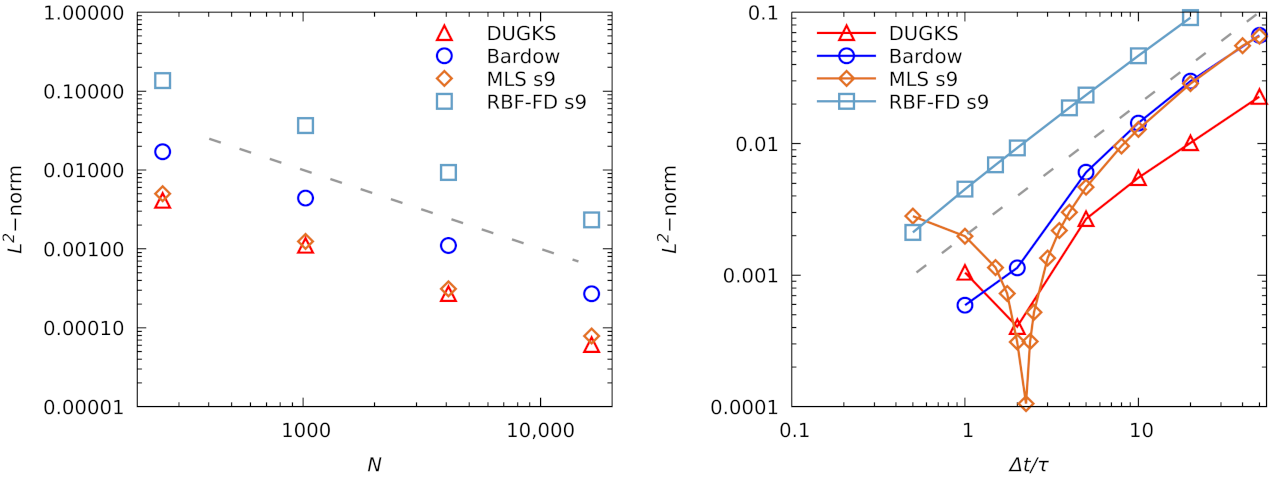
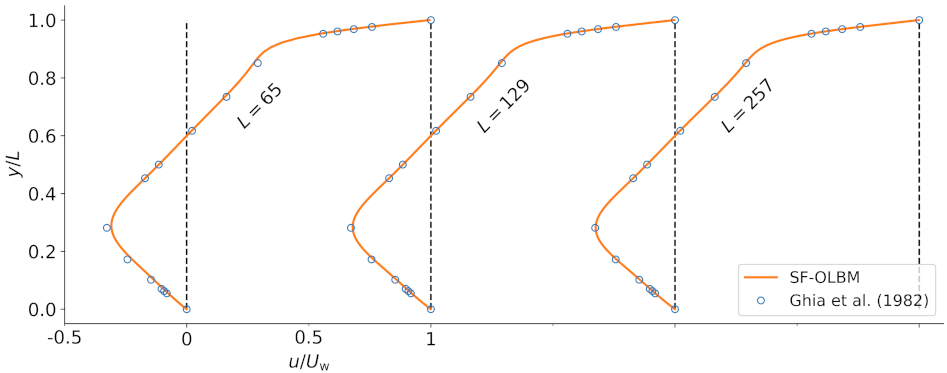
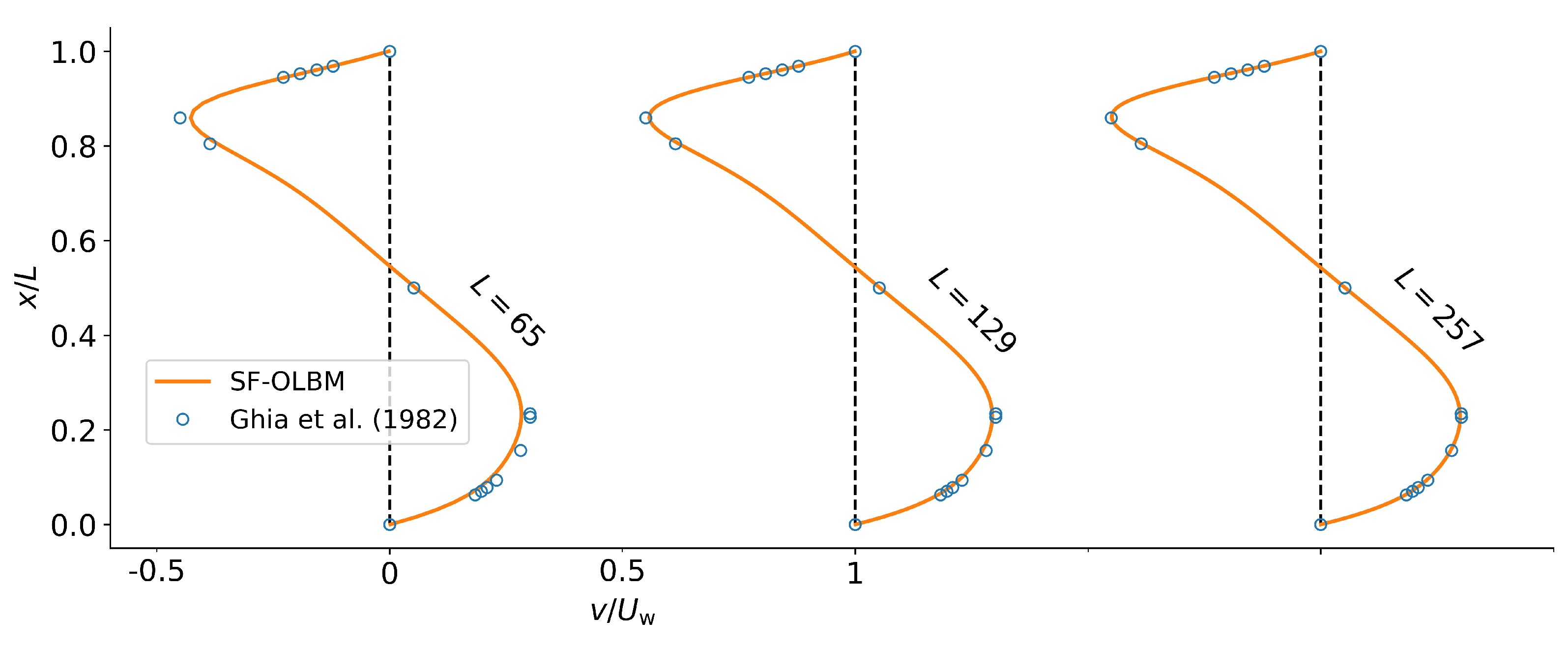

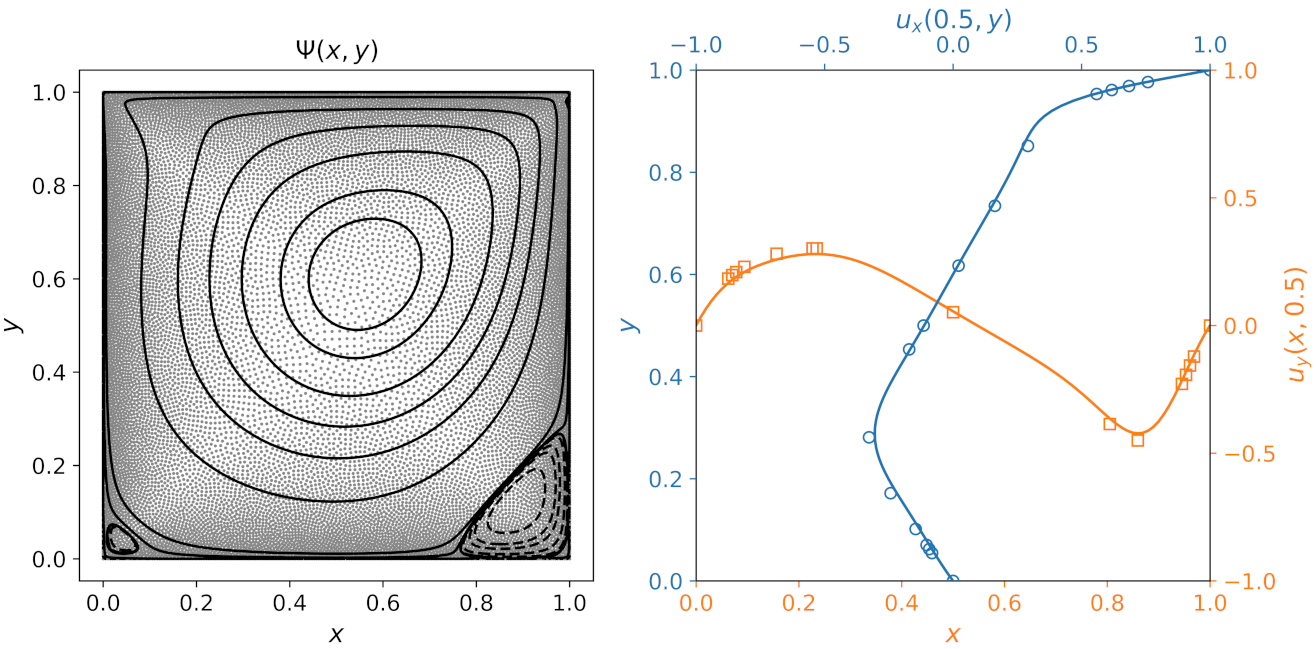
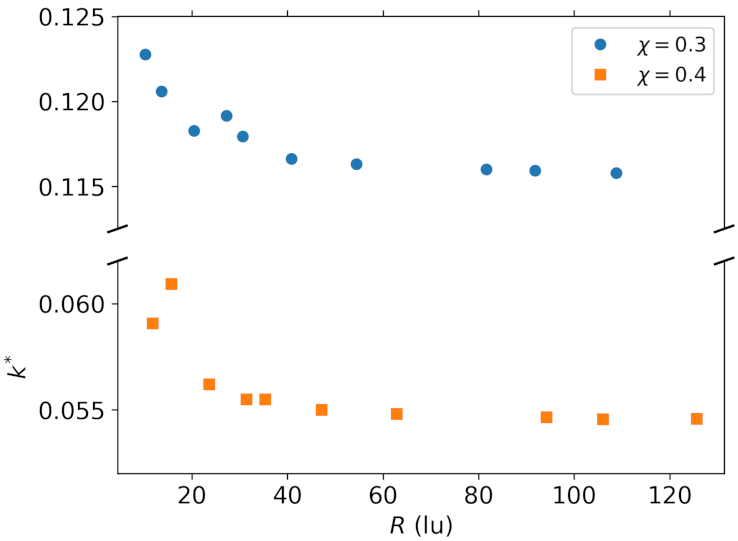
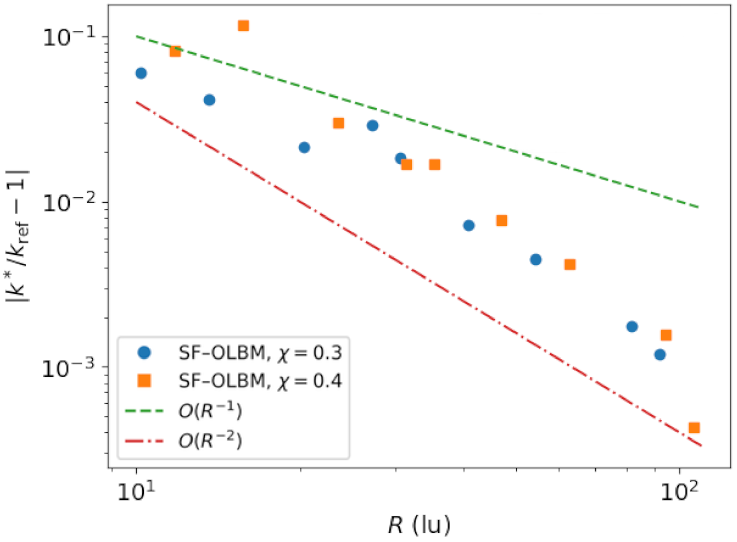
| Abbreviation | Weight | RBF | Monomials | Stencil Size |
|---|---|---|---|---|
| RBF-FD s9 | 9 | |||
| RBF-FD s13 | 13 | |||
| RBF-FD s21 | 21 | |||
| MLS s9 | Gaussian | 9 | ||
| MLS s13 | Gaussian | 13 | ||
| MLS s21 | Gaussian | 21 |
| Grid Size\Stencil Size | 9 | 13 | 21 |
|---|---|---|---|
| 2.9 | 3.5 | 5.0 | |
| 13.8 | 17.0 | 24.9 |
| 332 Grid | 992 Grid | 2972 Grid | 3522 Grid | Semi-Analytic [68] | LBM [67] | |||||
|---|---|---|---|---|---|---|---|---|---|---|
| Nodal average | ||||||||||
| 0.3 | 5.1561 (−8) | 0.12277 | 4.8166 (−7) | 0.11793 | 4.3671 (−6) | 0.11593 | 6.1393 (−6) | 0.11579 | ||
| 0.4 | 2.8141 (−8) | 0.05907 | 2.6303 (−7) | 0.05550 | 2.4004 (−6) | 0.05456 | 3.3797 (−6) | 0.05458 | ||
| Voxelized | ||||||||||
| 0.3 | 3.8299 (−8) | 0.12261 | 3.4311 (−7) | 0.12115 | 3.0800 (−6) | 0.12080 | 4.3259 (−6) | 0.12079 | 0.12210 | 0.12121 |
| 0.4 | 1.8533 (−8) | 0.05930 | 1.6220 (−7) | 0.05732 | 1.4544 (−6) | 0.05686 | 2.0427 (−6) | 0.05676 | 0.05767 | 0.05684 |
Publisher’s Note: MDPI stays neutral with regard to jurisdictional claims in published maps and institutional affiliations. |
© 2021 by the authors. Licensee MDPI, Basel, Switzerland. This article is an open access article distributed under the terms and conditions of the Creative Commons Attribution (CC BY) license (https://creativecommons.org/licenses/by/4.0/).
Share and Cite
Pribec, I.; Becker, T.; Fattahi, E. A Strong-Form Off-Lattice Boltzmann Method for Irregular Point Clouds. Symmetry 2021, 13, 1802. https://doi.org/10.3390/sym13101802
Pribec I, Becker T, Fattahi E. A Strong-Form Off-Lattice Boltzmann Method for Irregular Point Clouds. Symmetry. 2021; 13(10):1802. https://doi.org/10.3390/sym13101802
Chicago/Turabian StylePribec, Ivan, Thomas Becker, and Ehsan Fattahi. 2021. "A Strong-Form Off-Lattice Boltzmann Method for Irregular Point Clouds" Symmetry 13, no. 10: 1802. https://doi.org/10.3390/sym13101802
APA StylePribec, I., Becker, T., & Fattahi, E. (2021). A Strong-Form Off-Lattice Boltzmann Method for Irregular Point Clouds. Symmetry, 13(10), 1802. https://doi.org/10.3390/sym13101802





